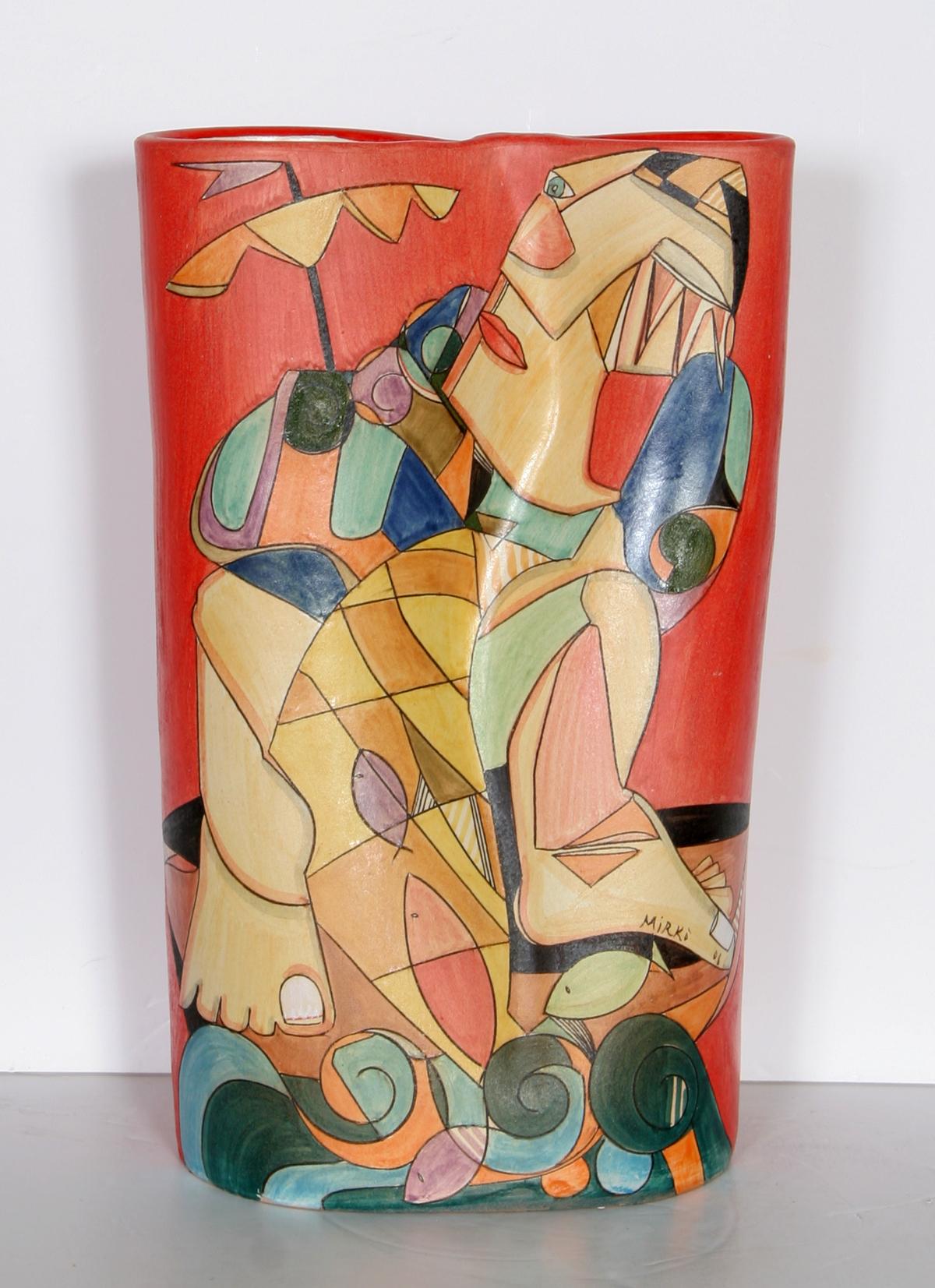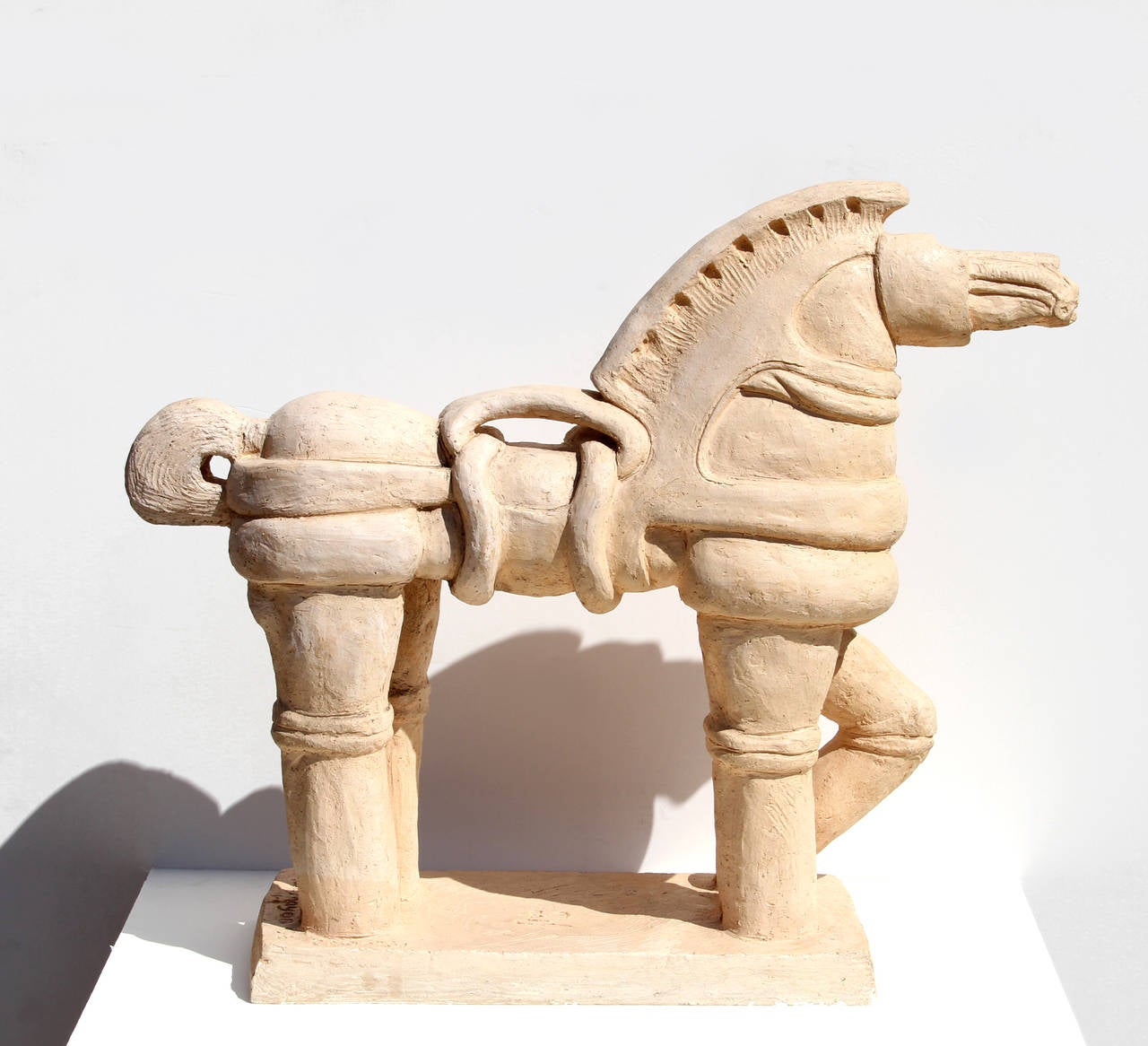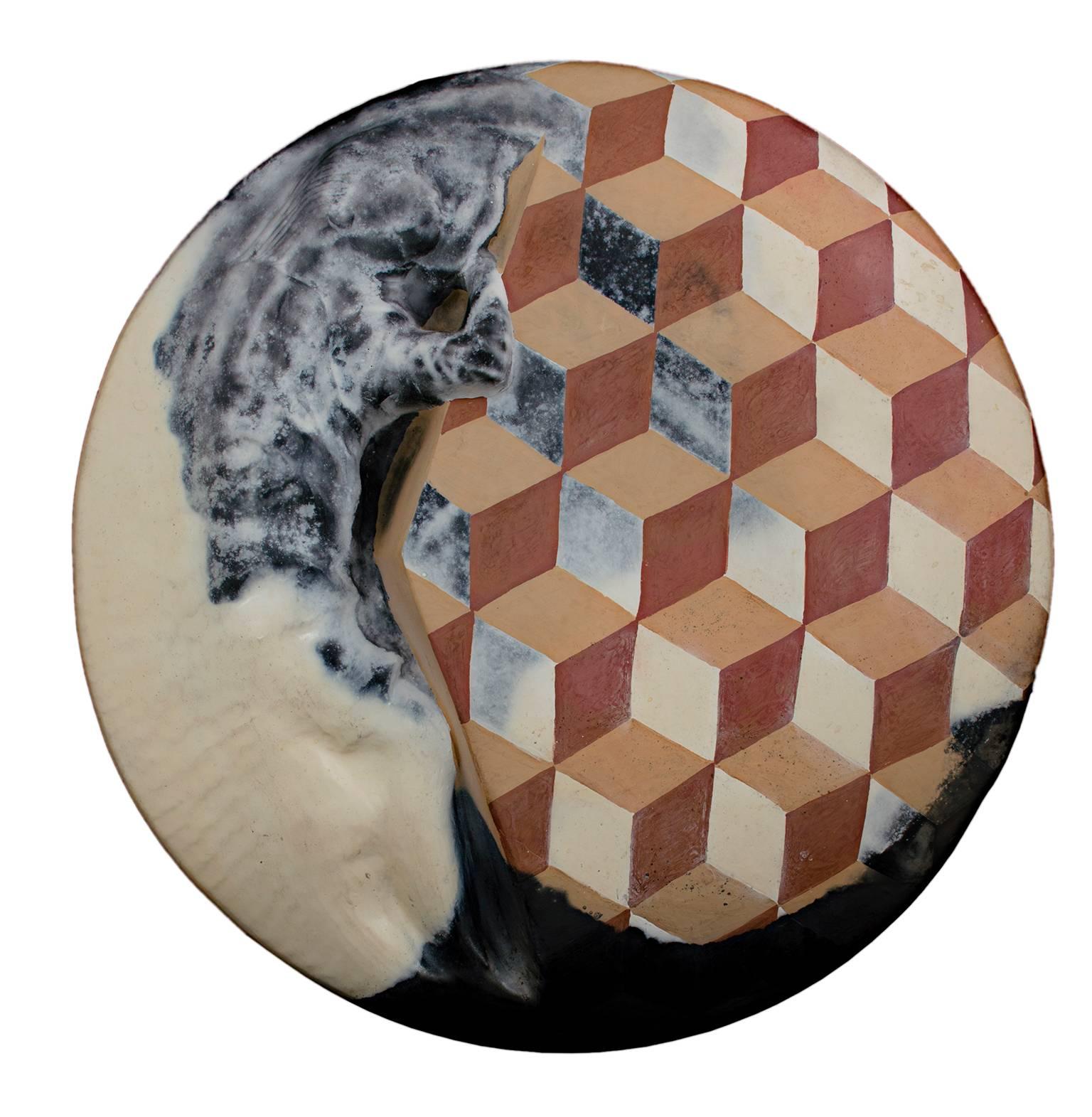Items Similar to Pre-Columbian Colima Shaman terracotta figure vessel Mexican sculpture
Video Loading
Want more images or videos?
Request additional images or videos from the seller
1 of 15
UnknownPre-Columbian Colima Shaman terracotta figure vessel Mexican sculpture ca. 300 BCE - 300 CE
ca. 300 BCE - 300 CE
About the Item
Seated Shaman
Colima culture
Mexico
ca. 300 BCE - 300 CE
Pre-Columbian, West Mexico, Colima, ca. 300 BCE to 300 CE. A hollow-cast and highly-burnished terracotta hunchback shaman figural vessel.
Hunchbacks were considered sacred in Pre Columbian cultures and are often depicted as shamans or as assistants to royalty. The shaman holds an oval vessel and shakes a rattle in his lively role within a feasting ritual. Feasting was one of the four most important themes portrayed in West Mexican art, along with kinship, status, and power (Butterwick, Heritage of Power, 2005, p. 12). Feasting ceremonies were an integral part of a community that solidified economic and social interaction within and between villages, engaging all levels of the society.
It is suggested that the rattles were peyote buttons which would be integral to any shamanic activity surrounding a religious feast. The known intoxicating liquids included octli, or pulque from agave plants, or tesvino, maize beer (Butterwick, in Townsend, ed., Ancient West Mexico, 1998, p. 103). This figure also wears the insignia of rank with the shell projection on the forehead secured with the incised band wrapped carefully around the chin and head. The stylized head faces the bowl with a solemn, determined visage comprised of coffee bean eyes, a pronounced pointed nose, pursed lips, and sensitively contoured facial planes, all topped by a caplike headdress with a horn rising from the center. A very unusual element is the small nose ring. The most curious aspect is the specific abnormality of the figure's spine. His back exhibits a protrusion not unlike an animal's tail, suggesting that the figure was based on a specific shaman. Overall, the graceful lines and studied proportions place this example among those of the highest distinction.
Colima, located on Mexico's southwestern coast, was during this time part of the shaft tomb culture, along with neighbors to the north in Jalisco and Nayarit. In this culture, the deceased were buried down shafts - ranging from 3 to 20 meters deep - that were dug vertically or near vertically through the volcanic tuff known as "tepetate" that makes up the geology of the region. The base of the shaft would open into one or more horizontal chambers with a low ceiling. These shafts were almost always dug beneath a dwelling, probably a family home, and seem to have been used as family mausoleums, housing the remains of many related individuals. Ornate vessels and finely modeled figures like this one were placed in the tombs in order to hold offerings and protect the soul of the deceased.
Condition: Thumb and bowl on left hand have broken off as one piece and have been reattached. Otherwise intact. Covered with nice burnishing marks.
All items legal to buy/sell under U.S. Statute covering cultural patrimony Code 2600, CHAPTER 14, and are guaranteed to be as described or your money back.
A Certificate of Authenticity will accompany all purchases
- Creation Year:ca. 300 BCE - 300 CE
- Dimensions:Height: 12 in (30.48 cm)Width: 12.25 in (31.12 cm)Depth: 8 in (20.32 cm)
- Medium:
- Period:
- Condition:
- Gallery Location:Wilton Manors, FL
- Reference Number:1stDibs: LU24525339032
About the Seller
4.9
Gold Seller
These expertly vetted sellers are highly rated and consistently exceed customer expectations.
Established in 2007
1stDibs seller since 2015
328 sales on 1stDibs
Typical response time: 9 hours
- ShippingRetrieving quote...Ships From: Wilton Manors, FL
- Return PolicyA return for this item may be initiated within 7 days of delivery.
More From This SellerView All
- Veracruz Mexico Pre-Columbian ceramic Warrior figure sculptureLocated in Wilton Manors, FLFigure of a Chanting Warrior Ceramic with bitumen highlights 300-600 CE (Classic Period) Mexico, Veracruz, possibly Nopiloa Veracruz Culture Pre-Columbian, Mexico, Vera Cruz culture...Category
15th Century and Earlier Figurative Sculptures
MaterialsCeramic
- Reclining Figure (woman)By William King (b.1925)Located in Wilton Manors, FLWilliam King (1925-2015). Reclining figure, ca. 1965. Cast and welded bronze, 7 x 9.5 x 5 inches. Unsigned. William King, a sculptor in a variety of materials whose human figures traced social attitudes through the last half of the 20th century, often poking sly and poignant fun at human follies and foibles, died on March 4 at his home in East Hampton, N.Y. He was 90. His death was confirmed by Scott Chaskey, who is married to Mr. King's stepdaughter, Megan Chaskey. Mr. King worked in clay, wood, bronze, vinyl, burlap and aluminum. He worked both big and small, from busts and toylike figures to large public art pieces depicting familiar human poses -- a seated, cross-legged man reading; a Western couple (he in a cowboy hat, she in a long dress) holding hands; a tall man reaching down to tug along a recalcitrant little boy; a crowd of robotic-looking men walking in lock step. But for all its variation, what unified his work was a wry observer's arched eyebrow, the pointed humor and witty rue of a fatalist. His figurative sculptures, often with long, spidery legs and an outlandishly skewed ratio of torso to appendages, use gestures and posture to suggest attitude and illustrate his own amusement with the unwieldiness of human physical equipment. His subjects included tennis players and gymnasts, dancers and musicians, and he managed to show appreciation of their physical gifts and comic delight at their contortions and costumery. His suit-wearing businessmen often appeared haughty or pompous; his other men could seem timid or perplexed or awkward. Oddly, or perhaps tellingly, he tended to depict women more reverentially, though in his portrayals of couples the fragility and tender comedy inherent in couplehood settled equally on both partners. Mr. King's work is in the collections of the Metropolitan Museum of Art and the Museum of Modern Art in New York and the Smithsonian American Art Museum in Washington, among other places, and he had dozens of solo gallery shows in New York and elsewhere. But the comic element of his work probably caused his reputation to suffer. Reviews of his exhibitions frequently began with the caveat that even though the work was funny, it was also serious, displaying superior technical skills, imaginative vision and the bolstering weight of a range of influences, from the ancient Etruscans to American folk art to 20th-century artists including Giacometti, Calder. and Elie Nadelman. The critic Hilton Kramer, one of Mr. King's most ardent advocates, wrote in a 1970 essay accompanying a New York gallery exhibit that he was, "among other things, an amusing artist, and nowadays this can, at times, be almost as much a liability as an asset." A "preoccupation with gesture is the focus of King's sculptural imagination," Mr. Kramer wrote. "Everything that one admires in his work - the virtuoso carving, the deft handling of a wide variety of materials, the shrewd observation and resourceful invention - all this is secondary to the concentration on gesture. The physical stance of the human animal as it negotiates the social arena, the unconscious gait that the body assumes in making its way in the social medium, the emotion traced by the course of a limb, a torso, a head, the features of a face, a coiffure or a costume - from a keen observation of these materials King has garnered a large stock of sculptural images notable for their wit, empathy, simplicity and psychological precision." William Dickey King...Category
Mid-20th Century Abstract Abstract Sculptures
MaterialsBronze
- Costa Rican pre-Columbian sculptural figure ca. 1000-1500Located in Wilton Manors, FLMagnificent standing figure, Costa Rica, ca. 1000-1500. Carved volcanic stone. Measures 16.5 x 9 x 5.5 inches. Outstanding condition with no damage. The figure represents a captured...Category
15th Century and Earlier Figurative Sculptures
MaterialsStone
- Standing FigureLocated in Wilton Manors, FLTom Cramer (b.1960). Standing Figure, 1998. Carved wood and polymer paint. Measures 17.5 inches high. Excellent condition. Signed and dated under base. Tom Cramer is an American artist working in Portland, Oregon noted for his intricately carved and painted wood reliefs and ubiquity throughout the city of Portland. Often called the unofficial Artist Laureate of Portland,[2] Cramer is one of the most visible and successful artists in the city. The influences on his work are both organic and technological. He is widely collected and is in many prominent west coast museum and private collections. He is in the permanent collections of the Portland Art Museum[3] in Portland Oregon, the Halle Ford Museum in Salem Oregon, the Jordan Schnitzer Museum in Eugene, Oregon, the Boise Art Museum in Idaho. Cramer made a name for himself in the 1980s and 1990s becoming a bridge between historical Oregon artists like Clifford Gleason and Milton Wilson...Category
Late 20th Century Neo-Expressionist Figurative Sculptures
MaterialsWood, Latex
- Standing FigureLocated in Wilton Manors, FLTom Cramer (b.1960). Standing Figure, 1980. Carved wood and polymer paint. Measures 11.5 inches high. Excellent condition. Signed and dated under base. Tom Cramer is an American artist working in Portland, Oregon noted for his intricately carved and painted wood reliefs and ubiquity throughout the city of Portland. Often called the unofficial Artist Laureate of Portland,[2] Cramer is one of the most visible and successful artists in the city. The influences on his work are both organic and technological. He is widely collected and is in many prominent west coast museum and private collections. He is in the permanent collections of the Portland Art Museum[3] in Portland Oregon, the Halle Ford Museum in Salem Oregon, the Jordan Schnitzer Museum in Eugene, Oregon, the Boise Art Museum in Idaho. Cramer made a name for himself in the 1980s and 1990s becoming a bridge between historical Oregon artists like Clifford Gleason and Milton Wilson...Category
Late 20th Century Neo-Expressionist Figurative Sculptures
MaterialsWood, Latex
- Standing FigureLocated in Wilton Manors, FLTom Cramer (b.1960). Standing Figure, 1988. Carved wood and polymer paint. Measures 11.5 inches high. Excellent condition. Signed and dated under base. Tom Cramer is an American artist working in Portland, Oregon noted for his intricately carved and painted wood reliefs and ubiquity throughout the city of Portland. Often called the unofficial Artist Laureate of Portland,[2] Cramer is one of the most visible and successful artists in the city. The influences on his work are both organic and technological. He is widely collected and is in many prominent west coast museum and private collections. He is in the permanent collections of the Portland Art Museum[3] in Portland Oregon, the Halle Ford Museum in Salem Oregon, the Jordan Schnitzer Museum in Eugene, Oregon, the Boise Art Museum in Idaho. Cramer made a name for himself in the 1980s and 1990s becoming a bridge between historical Oregon artists like Clifford Gleason and Milton Wilson...Category
Late 20th Century Neo-Expressionist Figurative Sculptures
MaterialsWood, Latex
You May Also Like
- Vase delle Braccia, Hand-Painted Unique Terracotta Vase by MirkoBy Mirko GuidaLocated in Long Island City, NYArtist: Mirkò, Italian (1980 - ) Title: Vaso delle Braccia (Three Musicians) Year: 2007 Medium: Painted Terracotta Vase, signed Size: 18 x 19 x 13 in. (45.72 x 48.26 x 33.02 cm)Category
Early 2000s Contemporary Figurative Sculptures
MaterialsTerracotta
- Fisherman II, Unique Painted Terracotta Vase by MirkoBy Mirko GuidaLocated in Long Island City, NYArtist: Mirkò, Italian (1980 - ) Title: Fisherman - II Year: 2006 Medium: Painted Terracotta Vase, signed and dated Size: 15 in. x 8 in. x 5.5...Category
Early 2000s Contemporary Figurative Sculptures
MaterialsTerracotta
- Horse - Taal Mayon, Sculpture by Ben GonzalesBy Ben A. GonzalesLocated in Long Island City, NYTitle: Horse - Taal Mayon Year: 1981 Medium: Terra Cotta Sculpture, signed and dated Size: 20.5 in. x 23 in. x 6 in. (52.07 cm x 58.42 cm x 15.24 cm)Category
1980s Modern Figurative Sculptures
MaterialsTerracotta
- Felicor, Terracotta Wall Sculpture by Roberto MattaBy Roberto MattaLocated in Long Island City, NYFelicor by Roberto Matta, Chilean (1911–2002) Terracotta Wall Plaque, signature inscribed, numbered in ink Edition of 49/150 Size: 15 x 12.75 x 2.25 in. (38.1 x 32.39 x 5.72 cm) Fram...Category
1980s Surrealist Figurative Sculptures
MaterialsTerracotta
- "Wall Piece with Figure, " Terra Sigillata by Christine LePageBy Christine LePageLocated in Milwaukee, WI"Wall Piece with Figure" is a ceramic sculpture made with Terra Sigillata by Christine LePage. It features a figure in the left half and an abstract ge...Category
1980s Figurative Sculptures
MaterialsTerracotta, Ceramic
- Visage au trait oblique, Picasso, 1960's, Portrait, Male face, TerracottaBy Pablo PicassoLocated in Geneva, CHVisage au trait oblique, Picasso, 1960's, Portrait, Male face, Terracotta Visage au trait oblique Ed. 22/100 circa 1968-1969 Red erthenware tile painted in ...Category
1960s Post-War Figurative Sculptures
MaterialsEarthenware, Terracotta




